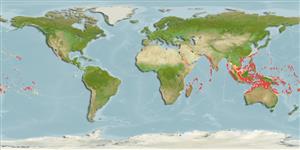Klassifizierung / Names
Namen | Synonyme | Catalog of Fishes(Gattung, Arten) | ITIS | CoL | WoRMS | Cloffa
Environment: milieu / climate zone / Tiefenbereich / distribution range
Ökologie
seewasser riff-verbunden; tiefenbereich 6 - 65 m (Ref. 9710). Tropical; 30°N - 24°S
Indo-Pacific: Red Sea and East Africa (Ref. 2334) to the Line and Mangaréva islands, north to Japan, south to New Caledonia.
Size / Gewicht / Alter
Geschlechtsreife: Lm ? range ? - ? cm
Max length : 11.0 cm TL Männchen/unbestimmt; (Ref. 48635)
Rückenflossenstacheln (insgesamt) : 8; Rückenflossenweichstrahlen (insgesamt) : 9; Afterflossenstacheln: 2; Afterflossenweichstrahlen: 8. Whitish with 5 horizontal stripes (brassy to dark brown in color); dark spot at base of middle caudal fin rays; fin rays light red (Ref. 2334). Greatest depth of body 2.7-3.2 in SL (Ref. 90102). Dorsal-fin rays VII-I, 9; anal-fin rays II, 8; pectoral fin rays 14; pelvic fin rays I, 5; pored lateral line scales 24; predorsal scales 4; circumpeduncular scales 12; total gill rakers 19, developed gill rakers 14; body white colored, with five poorly defined dark brown stripes on lateral surface of body, posterior end of third stripe reaching black spot on base of caudal fin; base of caudal fin with spot subequal in size to pupil (Ref. 93839).
Body shape (shape guide): short and / or deep; Cross section: compressed.
Commonly found in clear-waters of seaward reefs; on reef crests and slopes, where usually shallow, and along deep drop-offs to 25 m (Ref. 48635). Feeds on polychaetes and other small benthic invertebrates at night; cryptic under ledges or in holes by day (Ref. 1602). Solitary or in small groups (Ref 90102).
Life cycle and mating behavior
Geschlechtsreife | Fortpflanzung | Ablaichen | Eier | Fecundity | Larven
Mouthbrooders (Ref. 240). Distinct pairing during courtship and spawning (Ref. 205).
Myers, R.F., 1991. Micronesian reef fishes. Second Ed. Coral Graphics, Barrigada, Guam. 298 p. (Ref. 1602)
IUCN Rote Liste Status (Ref. 130435: Version 2024-2)
Bedrohung für Menschen
Harmless
Nutzung durch Menschen
Fischereien: kommerziell
Tools
Zusatzinformationen
Download XML
Internet Quellen
Estimates based on models
Preferred temperature (Ref.
123201): 25.3 - 28.8, mean 27.6 °C (based on 502 cells).
Phylogenetic diversity index (Ref.
82804): PD
50 = 0.5000 [Uniqueness, from 0.5 = low to 2.0 = high].
Bayesian length-weight: a=0.01380 (0.00754 - 0.02527), b=3.07 (2.91 - 3.23), in cm total length, based on LWR estimates for this species & Genus-body shape (Ref.
93245).
Trophic level (Ref.
69278): 3.3 ±0.32 se; based on food items.
Widerstandsfähigkeit (Ref.
120179): hoch, Verdopplung der Population dauert weniger als 15 Monate. (Preliminary K or Fecundity.).
Fishing Vulnerability (Ref.
59153): Low vulnerability (10 of 100).
🛈
Nutrients (Ref.
124155): Calcium = 131 [67, 209] mg/100g; Iron = 0.943 [0.552, 1.607] mg/100g; Protein = 18.5 [17.3, 19.7] %; Omega3 = 0.135 [0.077, 0.232] g/100g; Selenium = 36.9 [19.2, 70.5] μg/100g; VitaminA = 54.1 [15.5, 194.0] μg/100g; Zinc = 1.64 [1.10, 2.39] mg/100g (wet weight);
